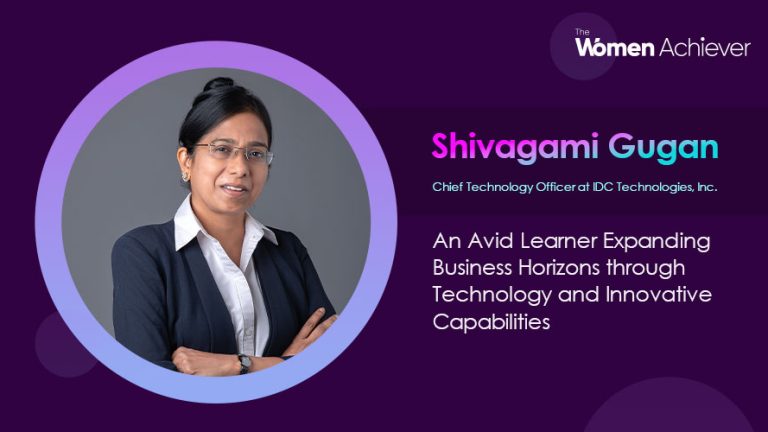As digital disruption continues to affect every industry across the globe and the pace of change becomes faster and faster, organizations are faced with a perfect storm that is driving their need for digitization. Since the competitive landscape is evolving rapidly, businesses need technology more than ever to improve their capabilities.
To meet the business opportunities and address the global challenges, technology and innovative thinking must fundamentally change the way businesses operate. Continuing as we have done over the past years is not sustainable and will impact the competitiveness of the businesses as companies will be able to keep up pace and scale of technology changes expected by market conditions.
IDC Technologies’ vision is to help organizations transform their businesses to be fuelled by technology and innovative capabilities. The company is the global provider of innovative software solutions and services operating out of the United States, India, the Netherlands, Singapore, Canada, Malaysia, Germany, Denmark, Dubai, the United Kingdom, Poland, Mexico, Columbia, and Australia. The core team at IDC builds and operates IT solutions and infrastructures, helps companies transform into modern technologies, and provides manpower skills and consultancy services. The company’s service portfolio also includes providing business process outsourcing (BPO) services and help desk facilities across retail, BFSI, telecom, collections and receivables management, and IT.
With over 20 years of experience, IDC’s global network of passionate technologists and pioneering architects implement the right technology blueprints and architecture to drive successful customer outcomes. Founded in 2003, the company specializes in centers of excellence in data engineering and big data service, AI, ML, DL, IoT, AR, VR, Metaverse, Digital Twins, Web and Mobile, ERP, DevSecOp and SRE, and Cloud implementation services. It has helped several Fortune500 companies embrace innovation, adopt new technologies, and implement technology transformations. IDC’s services include offshoring and nearshoring services to deliver business value and faster time to market.
A Transformative Leader Driving the Digital Revolution
Shivagami Gugan is the Group Chief Technology Officer at IDC Technologies. She is a technology transformation leader with international experience in building digital strategies with over 22 years of aviation and financial domain expertise. She specializes in building IT organizational strategies, delivering large portfolios, running software engineering and operations, vendor management and outsourcing strategies, service management, DevSecOps, Cloud, and SRE operations in large-scale, mission-critical IT environments. Shivagami has accomplished 30% improvements in efficiencies and up to 4X times improvement in software release cycles over 20 months.
Having led multi-million-dollar technology and enterprise data transformations for the Emirates Group, she joined IDC as their Global Group CTO to further expand their businesses and extend the service portfolio into digital domains. The team helps in exploring new technology frontiers to strategize, leverage, and build solutions that can deliver sustainable value for the industry.
Climbing the Corporate Ladder with a Unique Mindset
Shivagami has gradually climbed the ladder from being a software engineer to becoming a CDIO based on 3 key principles namely empathizing the colleagues and stretching beyond responsibilities to always deliver more, remaining fearless and constantly learning to implement new ways, and encouraging and empowering the team by building a strong fail-safe culture.
She says that organizational successes are built based on trust and discretionary efforts. Besides, leadership plays a key role in building employee contributions.
Envisaging Challenges with the Inertia to Transform
Shivagami reveals that the primary challenge organizations face is the inertia to transform, especially, if there has been an early success. The hubris that followed made her believe that the outdated and inefficient ways of working will take them through the future. She adds that organic growth often results in an overly complex technology landscape that is not fit for the future, and there is often a lack of a holistic investment portfolio view, supporting the strategic goals of the organization. Her primary challenges have been in getting the right people to believe that in the digital VUCA world, it’s a matter of time before their business will be ignored or bypassed.
Shivagami believes that businesses can achieve success only by working with the brightest in this industry and equipping people with digital skills, tools, and the workplace. “A journey that will challenge us to rethink what we know about technology delivery and management, to redefine what it is to be a leader, and to create a working environment that enables our people to reach their potential and deliver bold and innovative new initiatives which differentiate our company, and to create an environment wherein our people are proud to work and are enabled to do their best,” she adds.
The Building Blocks of an Efficient CDIO
Shivagami asserts that there are technical traits and soft traits that are vital attributes of a CDIO. On the technical competence, she suggests empowering the team, but this doesn’t mean that leaders lose the relevance of the subject matter. An outstanding leader is still an expert in the subject matter. They can set the context and strategize and can provide expertise, guidance, and mentorship as needed by the team. In this dynamic world, this is a super competency as this warrants the CDIO to be a life-long student of the subject matter. The change from “learn to know” to “know to learn” in a continuum makes a great leader. Often this would mean leaders will have to learn to unlearn and relearn continuously.
She encompasses some of the other characteristics like
- Integrity
The compass of a person is the core integrity, at work or outside work. Aristotle said leadership cannot occur in the absence of three things—logos, pathos, and ethos. Logos is logic—making a rational appeal. Pathos is emotion—making an argument that resonates with people on an emotional level. Ethos is super critically important, ethos is character. If the team doesn’t trust the leader because they have shown a lack of character, they are less likely to follow them and embrace their ideas. Even if they do, it will be due to fear, with a shallow commitment.
- Consistency
As a CDIO, leaders have the right to adapt to scenarios but always do so against a consistent framework. If as a leader, you say one thing in public, but act very differently with employees, the team will get demoralized. She says consistency matters. Leaders who deliver inspiring speeches are respected, but employees are far more inspired when the leader walks the talk. Employees continuously are watching for consistency in words and actions.
- Communication skills
There is no over-investment in communication. Professionals who stand out from their peers are often the ones who practice presentations and who work on improving their public-speaking skills. Being competent, having the courage to speak, and presenting your ideas are paramount.
- Courage and Confidence
A leader can be competent in his/her role, but he/she needs to build up the courage to speak up the ideas. This advice is along the lines of what Wharton professor Adam Grant wrote in his bestselling book, Originals. A leader original is a person who “champions a set of novel ideas that go against the grain but ultimately make things better”. Their ideas may be priceless, but it is still meaningless unless they can advocate the ideas effectively.
Denting the Business Sector with Systemic Approach
At IDC Technologies, Shivagami and her team follow a systematic approach to identify the current state. She says that they take a holistic view of people, processes, and technology and use design thinking principles to perform the gap analysis with the goals of the business.
The core architecture principles that her team applies during such transformations include:
- Domain-driven service design
- Intelligent systems
- Loosely coupled API first, real-time integrations
- Platforms based approach
- Everything monitored
- Secure everything
- Always on (High Availability and Disaster Recovery)
- Autonomous and resilient
- Performance engineered
- Multivariance testing
Shivagami highlights that IDC Technologies implements technology platform and IT architecture that is flexible, elastic, pluggable, loosely coupled, and highly available in line with current composable business architectures. This results in business outcomes that enable faster time to market with better costs and quality.
‘Big Data’ as a Trigger to Disruptive Solutions
At IDC Technologies, we believe that the bedrock of Web 3.0 and the Metaverse is based on ML, computer vision, data science, and big data technologies, remarks Shivagami. She presumes that the value of data has never been clearer. But often, data remains siloed within applications, which means it’s not being used as effectively as possible. Data fabric integrates data across platforms and users, making it available everywhere it’s needed. The real value of data exists not in simply having it, but in how it’s used for AI models, analytics, and insight.
The key tenants that impact innovation is what can be classified as the 3 are:
Intelligence
- Data mastery and AI, ML, DL, Image, and Voice Processing
- Big Data (Volume, Velocity, Variety)
- Context-Aware Business Process, Customer Experience, Employee Experience (Multi-Channel)
- Virtual Assistants on the Edge
Integration
- Digital Platform, APIs, and Ecosystems
- Mesh App and Service Architecture (MASA)
- Building a hybrid integration platform
Inbuilt Immutability and Scalability
- Cloud-native platforms use the core elasticity and scalability of cloud computing to deliver faster time to value. They reduce dependencies on infrastructure, freeing up time to focus on application functionality instead.
- Digital Product Delivery Organisation (Agile Release Trains)
- Continuous Modernisation (Cloud, Automation, Edge)
- Granular stack (Microservices, Containers, Distributed Services)
Getting Better and Ahead with ‘Servant Leadership’
Shivagami asserts that servant leadership is a framework for leadership that emphasizes what a leader can offer to their organization and their community. She mentions some of the few fundamental switches in the role of leaders in the past few years:
1) She reveals that the collective wisdom of her team is better than her own wisdom. Hence, she is not a know-it-all superior, but rather a steward and an enabler.
2) Shivagami’s team is motivated and will deliver outcomes if the vision is clear. The team will chart their own course towards the goal. Her job is to draw the vision enable them, be amidst them, coach them, and help by removing impediments.
These are a few questions that she tries to ask herself that have helped her excel as a leader:
- How do I build strong, empowered, independent teams?
- How do I “Show the Taj” and let the teams have a clear understanding of the customer? How do I make the purpose of the existence of the team clear?
- How do I define outcomes and help them as they chart their own path towards the outcomes? In other words, how do I set the context and not be directive?
- Am I building required integrations between the empowered teams?
- Am I a good team facilitator?
- How inclusive am I?
- Am I looking for options and approving recommendations from the team, rather than directing them?
- Do I select the right people who can speak up?
- Do I create an environment of mutual trust?
- Do I let go?
- I am driving diversity by design?
- Do I give the team enough time and space?
- I am fast enough to react to un-loyal members?
- How lean-agile am I? How can I take an active role to lead the implementation of the new way of working?
- How can I guide the activities necessary to understand and continuously optimize the flow of value through the organization?
- How can I identify excessive lead times, bottlenecks and WIP?
- How can I organize to focus on eliminating waste and delays? How can I eliminate demotivating policies and procedures?
- More importantly, how can I inspire and motivate the team to be autonomous with responsibility?
- How can I create a fail-safe environment that would create a culture of relentless improvement that provides the space required for teams to innovate?
She says that the best leaders she knows are good human beings. They lead by example. They are servant leaders. To this, she adds, “Digital Leadership is interesting – you do not feel ‘So lonely at the Top’. You may miss the corner glass room, but being amidst the fanfare, opens your mind and there is nothing more rewarding than ‘Learning to Learn’ from your colleagues every day.”
A Piece of Shivagami’s Mind for Emerging CDIOs
Shivagami suggests that having clarity in the goals, believing in a few core concepts and constantly learning about them, and becoming an expert and applying them diligently in the pursuit of perfection are some of the traits that will help emerging leaders. She concludes by saying that success is a by-product and will come along.
Quote: “Digital Transformation is often seen as being smoky, misty, and fearful. In reality, it is about a clear vision of committed leadership towards empowered employees adopting next-gen technologies, automation, agile approaches and building progressively a strong fail-safe environment”
– Shivagami Gugan, Group Chief Technology Officer at IDC Technologies, Inc.
Management: Shivagami Gugan, Group Chief Technology Officer at IDC Technologies, Inc.
Website: https://idctechnologies.com/idcdigital






Add comment